
|
|
Meet the IWC Team
|
|
|
|
|
|
|
|
FLAVOUR COLOURS
|

|
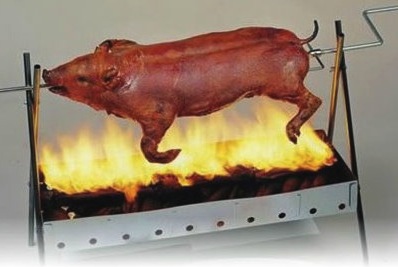 Ivory: Suckling pig 化皮乳豬 Ivory: Suckling pig 化皮乳豬
Most people may think suckling pig, with its fat and crispy skin, is a heavier dish
that goes best with red wine. Actually it is surprisingly delicate, especially if
you dip it in sugar and mustard, which adds extra dimensions of flavour and cuts
away the fat. The best wine to go with it will be a nice Chardonnay from Margaret
River, New Zealand or (of course), Burgundy. If you insist on red, try Pinot Noir
or Dolcetto.
Check out this and more Chinese food and wine matches in Flavour Colours, our Chinese food and wine pairing iPhone/iPad
App.
|
|
|
back to top
|
|
WHAT'S IN THE GLASS
|
|
Did you know?
|
 Residual sugar
Residual sugar
Sugar in grapes is converted into alcohol during the fermentation process, at a
rate of approximately 16.5g/l of sugar to 1% alcohol. If sugar is not fermented
completely, residual sugar will be left behind, contributing to the sweetness. Under
normal circumstances, grapes are harvested when the sugar level is between 180g/l
and 230g/l. Therefore, a German Kabinett Riesling with 8% alcohol will have approximately
40g/l residual sugar. For sweet wine, sugar in grapes is concentrated by dehydration
(eg. noble rot wine, ice wine, straw wine). The sugar level may reach over 300g/l
before fermentation, resulting in wine with 12% alcohol and 100g/l residual sugar.
Fermentation may stop naturally or be deliberately stopped by the winemaker. Winemakers
may add 2-5g/l süssreserve (concentrated grape juice) to dry wine for a more pleasing
palate.
|
Tersina has made wine in Portugal, South Africa and England. Follow her blog or
email her for any wine queries.
|
|
Appreciating Riesling
 Attendees at the recent ‘A Riesling Journey
into Summer’ masterclass led by Carsten Klane from German Fine Wine and Clemens Busch, a biodynamic winemaker from Mosel, were
pleased to learn the different impact of slates (blue, red and grey) on the structure
and fruit profile of Riesling. We also tasted German Riesling alongside Rieslings
from Alsace and Australia, and the differences were obvious. German Riesling has
a tighter and leaner structure, especially the Mosels which can be steely, while
Alsatian Riesling is bolder. Australian Riesling is generous but lacks the subtlety
of those from the Old World when sipping side by side. In the evening, Carsten and
Clemens invited wine lovers to try different Rieslings with various Chinese canapés,
including some classic pairings such as sautéed chicken in chilli sauce with Riesling
Spatlese and Auslese; and some creative parings like Peking duck with Grosses Gewächs
dry Riesling from Pfalz. Guests praised the tasting as an eye opener to the diversified
styles of German Riesling. Wines available at German Fine Wine. Read more Attendees at the recent ‘A Riesling Journey
into Summer’ masterclass led by Carsten Klane from German Fine Wine and Clemens Busch, a biodynamic winemaker from Mosel, were
pleased to learn the different impact of slates (blue, red and grey) on the structure
and fruit profile of Riesling. We also tasted German Riesling alongside Rieslings
from Alsace and Australia, and the differences were obvious. German Riesling has
a tighter and leaner structure, especially the Mosels which can be steely, while
Alsatian Riesling is bolder. Australian Riesling is generous but lacks the subtlety
of those from the Old World when sipping side by side. In the evening, Carsten and
Clemens invited wine lovers to try different Rieslings with various Chinese canapés,
including some classic pairings such as sautéed chicken in chilli sauce with Riesling
Spatlese and Auslese; and some creative parings like Peking duck with Grosses Gewächs
dry Riesling from Pfalz. Guests praised the tasting as an eye opener to the diversified
styles of German Riesling. Wines available at German Fine Wine. Read more
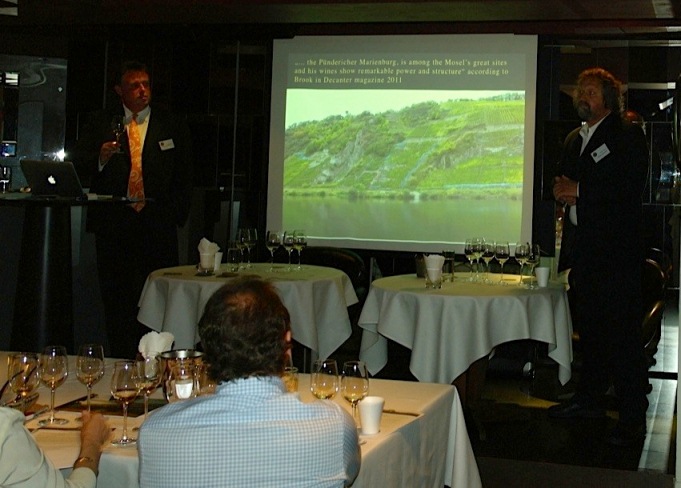 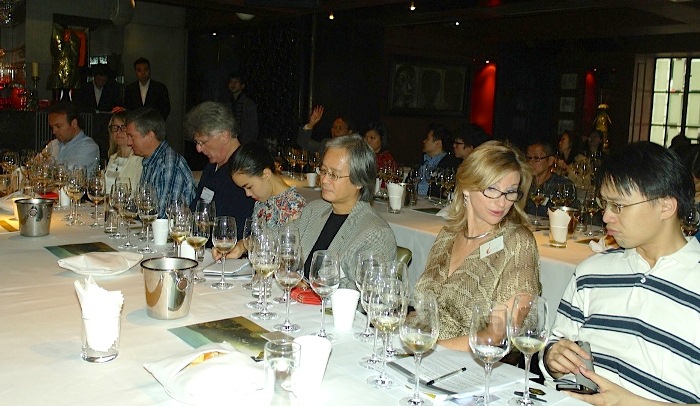
The pairings for the evening were:
The Douro Boys
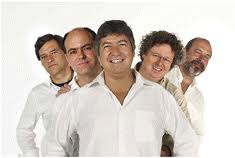 Apart from port, the next best thing from
the Douro (or indeed Portugal) from a wine perspective is probably the Douro Boys.
An alliance of five independent family estates: Quinta do Vallado, Quinta do Crasto, Quinta do Vale D. Maria, Quinta do Vale Meão and Niepoort, Douro Boys was created in 2003
to ‘put the Douro on the map’. The light-heartedness of the group’s name contrasts
nicely with the considerable avoirdupois (weight) of its members: dynamism and determination.
They are accessible but the wines are serious. Each quinta has its own style and
together they offer a good breadth of selection. With their energy, enthusiasm and
commitment, they trot the globe, reviving the Douro image and in fact raising the
overall quality standard of Douro wine. The international press writes about them
with passion; critics rate their wines with respect and wine lovers, well, just
love their wines.
Read more Apart from port, the next best thing from
the Douro (or indeed Portugal) from a wine perspective is probably the Douro Boys.
An alliance of five independent family estates: Quinta do Vallado, Quinta do Crasto, Quinta do Vale D. Maria, Quinta do Vale Meão and Niepoort, Douro Boys was created in 2003
to ‘put the Douro on the map’. The light-heartedness of the group’s name contrasts
nicely with the considerable avoirdupois (weight) of its members: dynamism and determination.
They are accessible but the wines are serious. Each quinta has its own style and
together they offer a good breadth of selection. With their energy, enthusiasm and
commitment, they trot the globe, reviving the Douro image and in fact raising the
overall quality standard of Douro wine. The international press writes about them
with passion; critics rate their wines with respect and wine lovers, well, just
love their wines.
Read more
Try yourself to see which of the Douro Boys is your style. Distributor of:
|
|
|
|
back to top
|
|
TASTE THIS SPACE
|
|
Justin Nugent from Bird in Hand talks about his the award winning sparkling Pinot
Noir
|
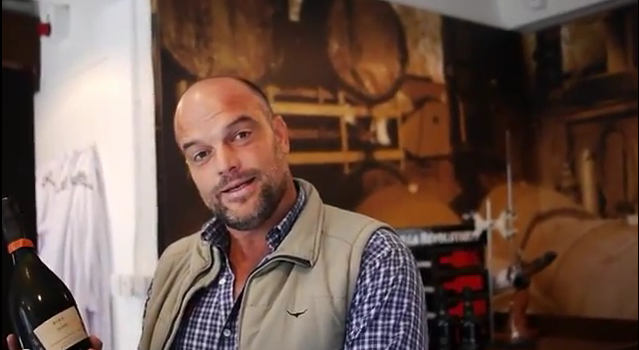
|
|
|
|
|
BETTANE & DESSEAUVE ON
FRENCH WINE REGION
|
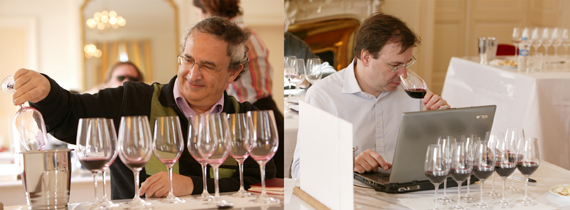
|
|
|
|
Alsace
This captivating region has many similarities to its German neighbour to the East,
and produces some of the best white wines France has to offer. The character of
the grape varieties that excel here is unmistakable- the elegance of Riesling, the
exuberance of Gewürztraminer, the depth of Pinot Gris and even the easy going character
of Sylvaner. Whether they be dry or late harvest wines, the characteristics of the
grapes come through with brilliance in the region, though it is easy to get lost
in the labyrinth of the appellation system here. One thing is for sure; the Grand
Cru wines of Alsace are among the best white wines in the world.
There are two categories of Alsace AOC wines:
 | AOC
Alsace: followed by the name of the approved varietal where wines are
exclusively produced |
| from a single grape variety. |
 | AOC Alsace Grand Cru: followed by the name of one of the four approved noble varietals
(Riesling, |
| Pinot Gris, Muscat, Gewurztraminer) and one of the fifty-one
official grands cru titles, including the |
| recently added Kaefferkopf Grand Cru. |
The designations 'Alsace Vendanges Tardives' and 'Alsace Sélection de Grains Nobles'
refer to quality wines that are made from very ripe grapes in accordance with strict
growing, winemaking and tasting procedures. Vendanges Tardives wines are produced
from naturally sugar-rich fruit that gives them superior body and ageing potential.
They usually retain a small quantity of residual sugar which limits their food-friendliness.
Sélections de Grains Nobles wines, as their name suggests, are based on grapes enriched
by Noble Rot and can compete with the greatest dessert wines in the world. Chaptalization
(the addition of sugar to the grape juice in order to increase alcohol levels) is
not permitted for either of these wines - a feature that makes them unique among
French wines. Crémant d'Alsace is a sparkling wine made in a fashion identical to
Champagne.
The varietals are the basis of Alsace wine production, but the terroir plays a key
role in the top-end wines. The recognition of that role came much later than elsewhere
in France. Today there is a policy of identifying wines by the lieudit (place name)
and commune of origin. The fifty best lieuxdits (place names) having even been promoted
to grand cru status. The most fruit-forward wines come from granitic, sandy soils,
such as those deposited in alluvial zones (on the Colmar plain, for instance). Sandstone
soils tend to give a mineral quality to the wines, though clay-limestone soils produce
an even more accentuated minerality and often need more time to develop in bottle.
Schistose and volcanic soils favour the development of intensely aromatic, complex
grapes that produce decidedly memorable wines.
|
|
|
|

|

|
|
Click here
for Bettane & Desseauve's ratings on 2010 Bordeaux.
|
|
|
|
|
MASTERS OF WINE INSIGHTS
|
|
|
|
Lisa Perrotti-Brown MW
|
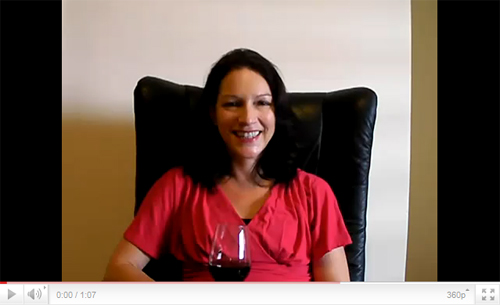
|
|
|
|
Lisa, "Where I come from in Maine, USA, we have this saying: "March is in like a
lion and out like a lamb," in reference to the weather – the harsh winter giving
way to a gentle spring. In the southern hemisphere of course the phrase should be
swapped, but wherever you are itʼs a time for change. So shake off your old tried
and trusted wines styles and reach for something new! My tip: New Zealand aromatic
varietals (Riesling, Pinot Gris and Gewürztraminer)...theyʼre really coming of age."
|
|
|
|
Ned Goodwin MW
|

|
|
|
|
Ned, 'When drinking wine ask yourself if you would like another glass, or perhaps
another. If one is naturally inclined to drink a third glass, it is proof that a
wine is balanced and clearly, for me at least, delicious.ʼ
|
|
|
back to top
|
|
NEAL MARTIN'S JOURNAL
|
|
 IWC is delighted to introduce Hong Kong wine lovers
to Neal Martin, an internationally acclaimed wine writer. We will feature Neal's
humorous yet informative wine diary on our website. Here is an excerpt from the
latest entry: IWC is delighted to introduce Hong Kong wine lovers
to Neal Martin, an internationally acclaimed wine writer. We will feature Neal's
humorous yet informative wine diary on our website. Here is an excerpt from the
latest entry:
The Vines that stood their ground: Laville, Mission &
Haut-Brion
In a somewhat solipsistic seaside town I enjoyed a blissful, parochial childhood,
oblivious to anything much further than the A13. Like the toy-towns on TV, I grew
up convinced that everything in Southend-on-Sea would remain the same, at least
until the end of time. C&A at the entrance of the Victoria Shopping Centre,
Tomassi’s ice-cream parlour at the bottom, Keddies the grand department store its
centre of gravity, the magical toy shop opposite Dixons and Lavelle’s the stationers,
where I would buy my weekly Beano with a packet of Pacers. I assumed that this conjugation
of retail outlets had been in situ since time immemorial until one day, mum broke
the news…“Lavelles is closing down,” she told me casually. “That is why some of
the shelves are empty.” .... read more
|
|
|
|
|
|
|
|
IWC TASTING AND COURSES
|
|
|
|
|
|
YUMMY QUIZ
|
|
Last month's question was: “Which construction is this?” The correct answer was
Cheval Blanc. We have an over-whelming response and a random draw picked Phil Brodie, winemaker of Te Mata in New Zealand as the
winner. Well done Phil, you have won a mystery bottle from the IWC cellar. Please
let us know next time you are in town to claim your prize.
This month’s question:
“All rosés are from the same region, what is the region?”

Prize: A bottle of wine from IWC’s cellar
(with all our global wine friends, you know you’ll be in for a treat!)
Send Us Your Answer here!
|
|
|
|
|
Get In Touch
|
|
For further inquiries, please visit our website,
email, or telephone: (852) 2549 0081
|
|